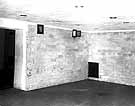
|
|
|

|

|

|

|
|
Click on an image to see a larger, more detailed picture.
|
|
|
|
|
| 1942: The "Final Solution" |

|
pg. 393 |

|
|
|
|
| |
 Mordechai Tenenbaum was active in the Vilna, Warsaw, and Bialystok underground movements. Tenenbaum was convinced of the Nazis' genocidal intentions at a very early stage. He arrived in Bialystok, Poland, in November 1942, and eventually unified the various underground movements and acquired additional weapons. Tenenbaum's call to arms was preserved in the archive that he established to chronicle the demise of Bialystok Jewry: "Let us fall as heroes, and though we die, yet we shall live."
Mordechai Tenenbaum was active in the Vilna, Warsaw, and Bialystok underground movements. Tenenbaum was convinced of the Nazis' genocidal intentions at a very early stage. He arrived in Bialystok, Poland, in November 1942, and eventually unified the various underground movements and acquired additional weapons. Tenenbaum's call to arms was preserved in the archive that he established to chronicle the demise of Bialystok Jewry: "Let us fall as heroes, and though we die, yet we shall live."
Photo: Yad Vashem / United States Holocaust Memorial Museum Photo Archive
|
 The first "official" concentration camp in Germany, Dachau housed thousands of prisoners from throughout Europe. Overcrowding, disease, medical experiments, and unrelenting work led to a high death rate, necessitating the building of a new and larger crematorium, with four furnaces, in 1942. Baracke X (Barrack 10) also contained a gas chamber (pictured). Disguised as a shower room, it was never put to use since the Nazis decided it was more efficient to send those judged mentally deficient or unable to work to killing sites, such as Auschwitz or Hartheim, Austria.
The first "official" concentration camp in Germany, Dachau housed thousands of prisoners from throughout Europe. Overcrowding, disease, medical experiments, and unrelenting work led to a high death rate, necessitating the building of a new and larger crematorium, with four furnaces, in 1942. Baracke X (Barrack 10) also contained a gas chamber (pictured). Disguised as a shower room, it was never put to use since the Nazis decided it was more efficient to send those judged mentally deficient or unable to work to killing sites, such as Auschwitz or Hartheim, Austria.
Photo: SYddeutscher Verlag Bilderdienst
|
 Showing the public hanging of a young man who tried to escape, this drawing represents the brutality of life in the Kovno (Lithuania) Ghetto. Mass killings in 1941 were followed by quieter days in 1942, a year free of large-scale Aktionen (deportations). Yet even in these "peaceful" days, the ghetto inhabitants daily encountered Nazi oppression. As this drawing from November 1942 shows, anyone who was caught breaking the ghetto's rules paid with his or her life.
Showing the public hanging of a young man who tried to escape, this drawing represents the brutality of life in the Kovno (Lithuania) Ghetto. Mass killings in 1941 were followed by quieter days in 1942, a year free of large-scale Aktionen (deportations). Yet even in these "peaceful" days, the ghetto inhabitants daily encountered Nazi oppression. As this drawing from November 1942 shows, anyone who was caught breaking the ghetto's rules paid with his or her life.
Photo: Beth Hatefutsoth
|
|

|

|

|

|
 December 1942: Nazis lock 1000 Gypsies in a Lithuanian synagogue until the prisoners starve to death.
December 1942: Nazis lock 1000 Gypsies in a Lithuanian synagogue until the prisoners starve to death.
|
 December 1942: Ghetto resistance is organized at Czestochowa and Kielce, Poland.
December 1942: Ghetto resistance is organized at Czestochowa and Kielce, Poland.
|
 December 1942: At Brody, Ukraine, Jewish resistance is led by Solomon Halberszstadt, Jakub Linder, and Samuel Weiler.
December 1942: At Brody, Ukraine, Jewish resistance is led by Solomon Halberszstadt, Jakub Linder, and Samuel Weiler.
|
 December 1942: Concurrent Jewish resistance at Chortkov, Ukraine, is led by Heniek Nusbaum, Mundek Nusbaum, Reuven Rosenberg, and Meir Wasserman.
December 1942: Concurrent Jewish resistance at Chortkov, Ukraine, is led by Heniek Nusbaum, Mundek Nusbaum, Reuven Rosenberg, and Meir Wasserman.
|
 December 1942: Jewish Resistance leader Dr. Yeheskel Atlas, a young Polish physician, is mortally wounded by Nazi troops in a battle at Wielka Wola, Poland.
December 1942: Jewish Resistance leader Dr. Yeheskel Atlas, a young Polish physician, is mortally wounded by Nazi troops in a battle at Wielka Wola, Poland.
|
 December 1942: The Jewish ghetto at Lvov, Ukraine, is liquidated.
December 1942: The Jewish ghetto at Lvov, Ukraine, is liquidated.
|
 December 1942: The SS shuts down extermination activities at Belzec.
December 1942: The SS shuts down extermination activities at Belzec.
|
 December 1942: A forced-labor camp is established at Plaszów, Poland.
December 1942: A forced-labor camp is established at Plaszów, Poland.
|
 December 1942: A Sonderkommando plan to escape from Auschwitz is discovered, and the inmates are gassed.
December 1942: A Sonderkommando plan to escape from Auschwitz is discovered, and the inmates are gassed.
|
 December 1942: Partisan leader Hirsch Kaplinski, survivor of an August 1942 massacre of Jews at Diatlovo, Belorussia, is killed in combat during a German attack on the Lipiczany Forest.
December 1942: Partisan leader Hirsch Kaplinski, survivor of an August 1942 massacre of Jews at Diatlovo, Belorussia, is killed in combat during a German attack on the Lipiczany Forest.
|
|
|
|
|
| 1942: The "Final Solution" |

|
pg. 393 |

|
|
The Holocaust Chronicle
© 2009 Publications International, Ltd.
|
|
